Automotive SbW System Market, 2031
The global automotive steer-by-wire system market size was valued at $2.7 billion in 2021, and is projected to reach $5.8 billion by 2031, growing at a CAGR of 8.5% from 2022 to 2031.
Steer-by-wire system is an advanced technology installed in vehicles, which eliminates the physical connection between vehicle's wheels & steering wheel by introducing an electrically controlled motor & steering module to change the direction of the wheels & provide comfortable driving experience to the driver. Integration of a steer-by-wire system significantly improves the safety and handling of the car. This is attributed to the fact that this system is easily modifiable, allowing different drivers to customize the system to suit their style and improve handling. In addition, disabled and elderly can benefit from steer-by-wire as the steering wheel can be positioned to suit their special needs.
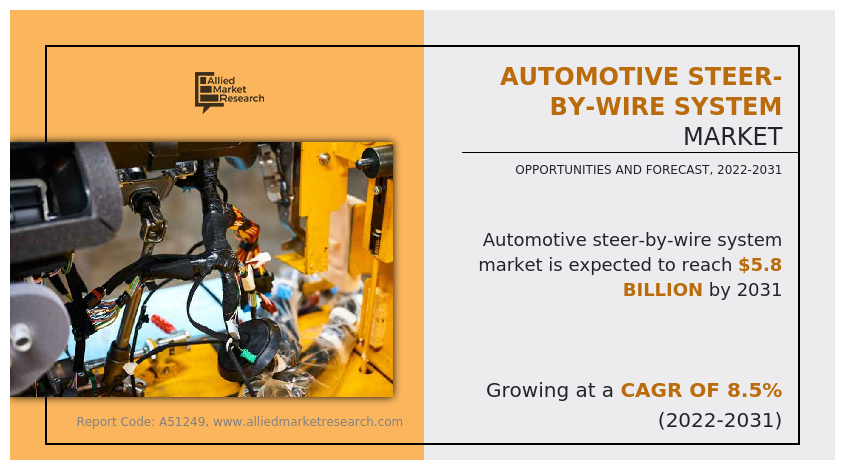
Furthermore, traction control systems that are closely related to driving safety can be improved by steer-by-wire. For instance, in a situation where the car begins to oversteer, the instinct of many inexperienced drivers is to turn the steering wheel inward, which causes more oversteer. In such situations, the steer-by-wire system can be modified to take control and steer outward. With few physical connections between the steering wheel and the wheels, steer-by-wire systems can be easily implemented in a range of vehicles. The steering wheel can be placed on either side of the car (or anywhere else). These two improvements reduce manufacturing costs and allow for a wider range of designs.
The growth of the global automotive steer-by-wire market is majorly driven by rise in concerns about vehicle safety & efficiency, increase in demand for ADAS, and surge in adoption in electric & autonomous vehicles. However, high maintenance costs and reluctance in adoption hinder the market growth. Conversely, enhanced driving experience, increase in demand for more advanced & efficient steering systems in the automotive industry, and benefits offered by steer-by-wire systems to disabled & elderly people are anticipated to provide lucrative opportunities for the market expansion.
The global automotive steer-by-wire system market is segmented into component, propulsion, vehicle type, and region. By component, the market is divided into steering actuator, feedback motor, angular sensors, and others. On the basis of propulsion, it is bifurcated into internal combustion engine (ICE) and electric. Depending on vehicle type, it is fragmented into passenger cars and commercial vehicles. Region wise, the market is analyzed across North America, Europe, Asia-Pacific, and LAMEA.
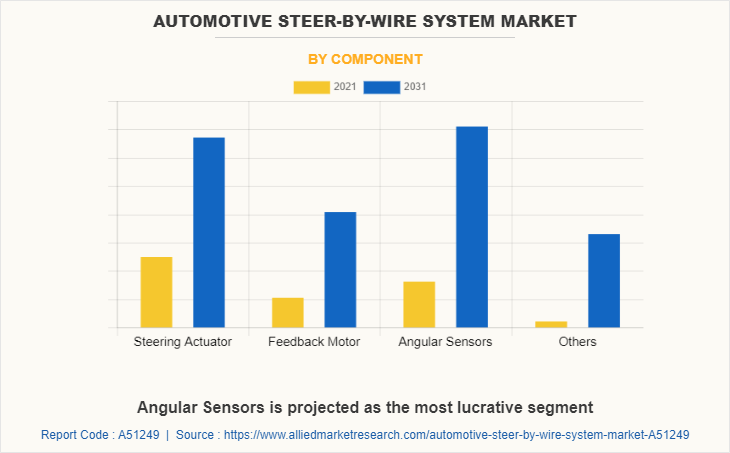
The key players operating in the global automotive steer-by-wire system market include Continental AG, Danfoss A/S, Hitachi Astemo, JTEKT Corporation, Mando Corporation, Nexteer Automotive Corporation, Robert Bosch GmbH, Schaeffler Ag, Thyssenkrupp AG, and ZF Friedrichshafen.
Rise in concerns about vehicle safety and efficiency
Steer-by-wire systems are designed to improve the safety and efficiency of vehicles by providing advanced driver assistance features and enhancing vehicle performance. These systems can play an important role in enabling the safety operation of autonomous vehicles by providing precise control and maneuverability.
The integration of steer-by-wire systems has resulted in significant improvements in vehicle safety and efficiency. For instance, in July 2022, ZF introduced its advanced steer-by-wire technology for the front axle. According to the company, this new, advanced steer-by-wire technology provides comfort and safety features, such as autonomous emergency evasive parking or maneuvers in confined spaces. Furthermore, these systems can be used to enable features such as lane departure warning and collision avoidance, which can help prevent accidents and improve vehicle safety.
In addition, steer-by-wire systems can improve vehicle efficiency by reducing the amount of power required for steering. Traditional steering systems are designed to provide a physical connection between the steering wheel and the wheels, which can result in a significant amount of energy loss. By using steer-by-wire systems, automakers can reduce the amount of power required for steering, resulting in improved fuel efficiency and reduced emissions. Heavy-duty trucks require significant power to operate, and fuel efficiency is a major concern for fleet operators. By integrating steer-by-wire systems, automakers can reduce the weight of the vehicle and improve the efficiency of the steering system, thereby resulting in significant fuel savings.
For instance, in September 2022, ZF introduced its advanced new electric power steering (EPS) system for trucks, coaches, and city buses. The EPS has been prepared for steer-by-wire and up to level 5 autonomous driving. Thus, the demand for steer-by-wire systems in the automotive industry is driven by safety concerns, fuel efficiency, and driver experience.
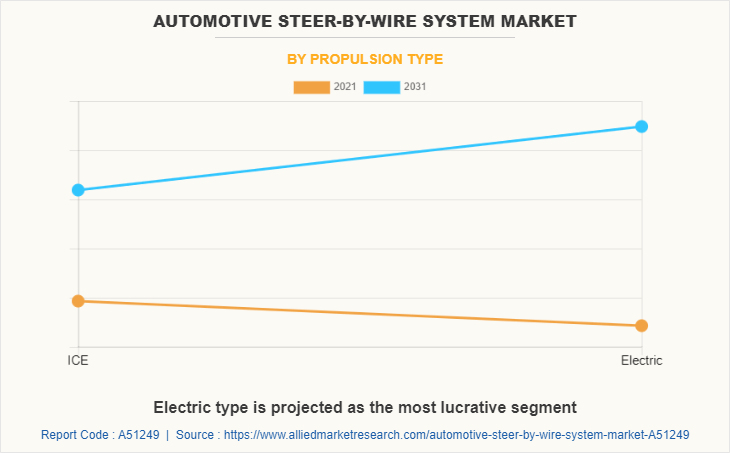
Increase in adoption in electric and autonomous vehicles
Steer-by-wire systems replace the traditional mechanical steering systems with electronic controls, offering enhanced precision, reliability, and safety. Electric vehicles benefit from steer-by-wire systems as they eliminate the need for heavy and complex mechanical components such as the steering column, rack, and pinion, and hydraulic pump.
This helps in reducing the weight of the vehicle, leading to increased efficiency and range. Autonomous vehicles further require advanced steering systems that can communicate with the vehicle's sensors and control systems to ensure safe and accurate navigation. Steer-by-wire technology enables this by allowing precise and immediate control of the vehicle's steering, regardless of whether the driver is present or not. Thus, the global automotive steer-by-wire system market is expected to grow significantly driven by increase in demand for electric and autonomous vehicles.
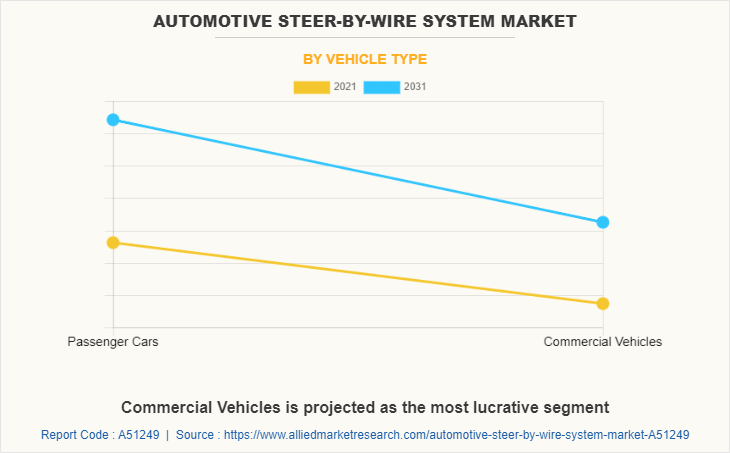
High maintenance cost
Steer-by-wire systems are electronic and computer-controlled; hence, they require specialized maintenance and repair services, which incur high cost. Moreover, as steer-by-wire system is a relatively new technology, lack of qualified technicians who can repair these systems has been witnessed. This leads to longer repair times and higher costs for consumers, thus hampering the market growth. In addition, the complexity of these systems results in more frequent maintenance and repair needs, which impact the overall ownership cost of the vehicle. This acts as a key deterrent factor, as consumers opt for traditional mechanical steering systems due to their lower maintenance costs. Furthermore, manufacturers of steer-by-wire systems will need to ensure that these systems are reliable and have a prolonged service life to minimize the maintenance and repair costs associated with them. They may need to invest in training programs to increase the availability of qualified technicians who can repair and maintain these systems, thus adding to the cost. All these factors collectively hamper the growth of the global market.
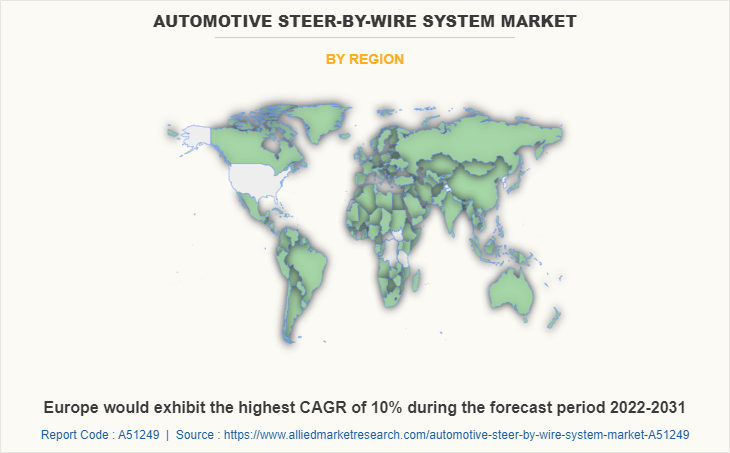
Increase in demand for more advanced and efficient steering systems in the automotive industry
As consumer expectations continue to evolve, car manufacturers are under increasing pressure to deliver vehicles with more advanced features and technologies. This includes steering systems that provide better performance, responsiveness, and efficiency. Steer-by-wire systems offer several advantages over traditional steering systems, including more precise and direct steering control, reduced weight & space requirements, and improved safety. For instance, in October 2022, Hitachi Astemo, Ltd. developed a new steer-by-wire steering device prototype that removes the conventional steering wheel and expands the cabin space. This initiative is expected to make steer-by-wire systems a suitable option for car manufacturers looking to differentiate their products.
In addition to consumer demand, regulatory and environmental factors drive the adoption of more advanced and efficient steering systems. For instance, governments around the world are implementing stringent emissions standards, which are driving the development of more fuel-efficient vehicles. Steer-by-wire systems can contribute to this goal by reducing the weight and energy consumption of steering components. Thus, increase in demand for more advanced and efficient steering systems in the automotive industry is expected to create significant opportunities for the expansion of the automotive steer-by-wire market during the forecast period.
Key Benefits For Stakeholders
- This report provides a quantitative analysis of the market segments, current trends, estimations, and dynamics of the automotive steer-by-wire system market analysis from 2021 to 2031 to identify the prevailing automotive steer-by-wire system market opportunities.
- The market research is offered along with information related to key drivers, restraints, and opportunities.
- Porter's five forces analysis highlights the potency of buyers and suppliers to enable stakeholders make profit-oriented business decisions and strengthen their supplier-buyer network.
- In-depth analysis of the automotive steer-by-wire system market segmentation assists to determine the prevailing market opportunities.
- Major countries in each region are mapped according to their revenue contribution to the global market.
- Market player positioning facilitates benchmarking and provides a clear understanding of the present position of the market players.
- The report includes the analysis of the regional as well as global automotive steer-by-wire system market trends, key players, market segments, application areas, and market growth strategies.
Automotive Steer-By-Wire System Market Report Highlights
| Aspects | Details |
| Market Size By 2031 | USD 5.8 billion |
| Growth Rate | CAGR of 8.5% |
| Forecast period | 2021 - 2031 |
| Report Pages | 264 |
| By Component |
|
| By Propulsion Type |
|
| By Vehicle Type |
|
| By Region |
|
| Key Market Players | Danfoss, JTEKT Corporation, Hitachi Astemo, Ltd., Continental AG, Robert Bosch GmbH, Nexteer Automotive, HL Mando Corp., Schaeffler AG, ZF Friedrichshafen AG, thyssenkrupp AG |
Analyst Review
The automotive steer-by-wire system market is expected to grow rapidly with the technology being increasingly adopted by prominent automotive manufacturers. The potential for steer-by-wire technology to provide enhanced safety features and comfortable driving experiences for customers creates ample opportunities for the growth of the market across the globe.
The elimination of mechanical links between the steering wheel and the wheel of the vehicle offers enhanced flexibility in vehicle design. This can lead to an advantage for companies that are able to successfully incorporate steer-by-wire technology into their vehicles. There are several examples of companies that are actively integrating steer-by-wire technology. For instance, in October 2021, Toyota introduced its first electric car, the bZ4X. This car features new steer-by-wire system, which enables lock-to-lock angle set approximately 150°, thus eliminating the need to change the grip when operating the steering wheel and reducing the burden on the driver when turning, in parking lots and on winding roads.
The CXOs further added that the steer-by-wire technology is still relatively new, with potential safety concerns that need to be addressed. In addition, there may be regulatory hurdles to overcome, particularly in terms of compliance with safety standards and approval from governing bodies. Moreover, it needs significant investment in R&D to improve the technology and ensure reliability. This can be particularly difficult for smaller companies without the financial resources of larger competitors.
The global automotive steer-by-wire system market was valued at $2,675.2 million in 2021, and is projected to reach $5,839.2 million by 2031, registering a CAGR of 8.5% from 2022 to 2031.
The key players analyzed in the report include Continental AG, Danfoss A/S, Hitachi Astemo, JTEKT Corporation, Mando Corporation, Nexteer Automotive Corporation, Robert Bosch GmbH, Schaeffler Ag, Thyssenkrupp AG, and ZF Friedrichshafen.
Asia-Pacific is the largest regional market for Automotive Steer-By-Wire System
Passenger cars is the leading application of Automotive Steer-By-Wire System Market
Introduction of sensor-based steering system in vehicles are the upcoming trends of Automotive Steer-By-Wire System Market in the world
Loading Table Of Content...
Loading Research Methodology...



